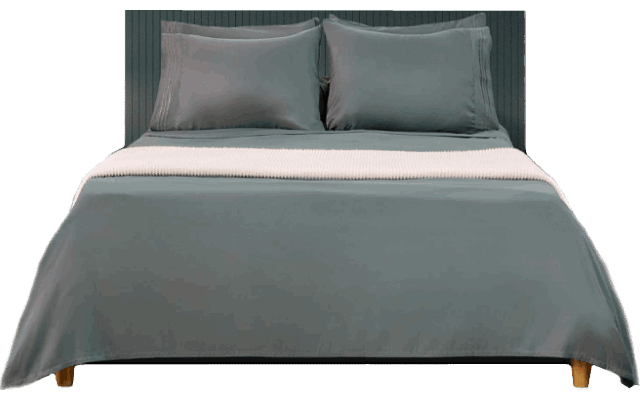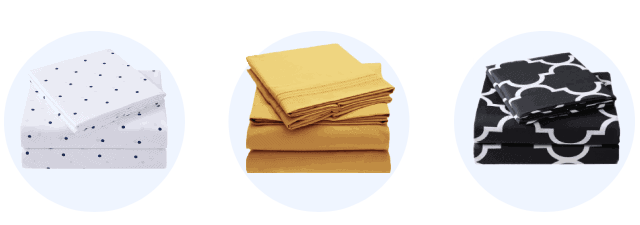If you love your gym outfits, towels, or cleaning cloth, chances are it’s made of microfiber. Microfiber was introduced only 35 years ago, so it’s still relatively new. This versatile fabric is used in every industry – you’ll find them in everyday products including your sheets! In fact, microfiber sheets are so popular that some prefer them over cotton or linen. If you’re thinking of doing the same, here are the pros and cons of microfiber sheets to consider before making the big change.

What Are Microfiber Sheets?
Microfiber is a fairly new, man-made fiber that’s very fine, with a thickness of 1/100 of a human hair in diameter. The thickness is measure in denier; silk, for example, is the thinnest natural fiber and weighs 1.5 deniers, while microfiber weighs less than 1 denier. This allows for microfibers to be finely woven together using percale or sateen weaves to produce sheets.
Topics Explored
- What Are Microfiber Sheets? »
- What Are They Made Of? »
- Pros and cons of a Montessori floor bed »
- What is the appropriate age for Montessori beds »
- Safety tips for floor beds »
What Are They Actually Made Of?
Because microfiber is so thin, it’s smooth and soft to the touch. This unique texture comes from using a combination of materials such as polymer and nylon. Nowadays, you can also find naturally-derived microfiber sheets made from wood pulp.
Pros and Cons of Microfiber Sheets

When we think of microfiber, the first thing that comes to mind is cleaning cloths and mops. Nowadays, you can find microfiber in just about any bedding product. Microfiber sheets are more popular than ever due to their affordability and soft feel.
Just because they’re popular, does it mean that microfiber sheets are the right choice for you? Let’s examine the pros and cons of microfiber sheets below.
Microfiber Sheets Pros:

Very Soft
If you’ve ever owned a microfiber towel (virtually impossible not to these days) then you’re more than familiar with its softness. Now imagine it in a sheet form. The extreme softness is one of the main perks of the microfiber sheets that rarely any other material delivers.
Durable
Microfibers on their own are thin and weak, but since their thinness allows for more complex weaves, they turn into a durable fabric. They can even be dust mite and bug resistant in some cases. While natural materials like cotton and linen can break down easier with prolonged use, microfiber is break-resistant for a more extended time.
Easy Maintenance
Microfiber sheets are low-maintenance; you can wash them with almost all detergents on the normal wash cycle, can be tumble or air dried, and rarely need ironing since they stay wrinkle-free. They can be very stain resistant but beware of microfiber with high absorbency power.
Affordable
While natural materials are becoming harder to source, synthetic materials become easier to produce. The price of microfiber sheets depends on the quality, but it’s way lower than a high-quality natural fiber like silk or Egyptian cotton. Expect to pay around $30 for high-quality microfiber sheets.
Microfiber Sheets Cons:

Can Be Warm
The tight weave makes the microfiber sheets less breathable and causes higher heat retention. Even though they’re moisture-wicking, they can trap heat and feel excessively warm while you sleep. This is a problem for those who sleep warm and suffer from night sweats.
Allergies
Materials like cotton and linen are naturally hypoallergenic and skin-friendly, which is not the case with microfiber. Microfiber can cause allergies in people sensitive to synthetic materials. Spending more than 8 hours a night on the microfiber sheet can trigger a lingering allergy.
Potentially Harmful to the Environment
Like some artificial materials, microfiber is not Mother Nature’s best friend. Each time when washed, the material unleashed microplastic in the water. While it’s very durable, it’s not biodegradable. The whole process of producing the microfiber is harsh on the environment.
How to Pick the Best Microfiber Sheets
Now that we learned about the pros and cons of microfiber sheets, let’s look at the three most important criteria when purchasing these sheets for home use.
 Size
Size
Look for a microfiber sheet that fits the size of your bed. While microfiber is not susceptible to wrinkling, it shouldn’t be bigger than your bed and bunch up. It also shouldn’t be too small and slide off each night when you toss and turn.
 Quality
Quality
When buying natural fiber sheets, you look for thread count as a quality guarantee. The microfiber sheet version of thread count is GSM- gram per square meter. It measures how densely woven the material is. The higher the GSM, the better the quality. High GSM means a heavier, more durable, but warmer sheet.
 Sleep Temperature
Sleep Temperature
Microfiber sheets are great at heat retention, which makes them the ideal winter bedding. If you tend to sleep hot or suffer from night sweats, they might not be the best choice. You can try a low GSM microfiber sheet or opt for a cotton one.
FAQs: Pros and Cons of Microfiber Sheets
Are microfiber sheets hot?
Microfiber is a tightly woven material that is known for trapping heat. Due to its super-soft feeling and heat retention, microfiber sheets are the perfect winter choice or an option for those sleeping cold. In short, yes, microfiber sheets are hot.
Do microfiber sheets pill?
Every material, whether natural or synthetic, is prone to pilling. However, some finishing processes like searing and mercerizing can lower the level of pilling. In comparison to cotton, microfiber is less prone to pilling, but low-quality microfiber sheets of 50 GSM will probably pill.